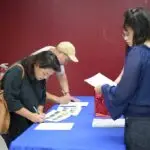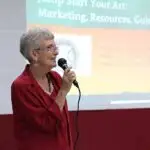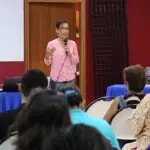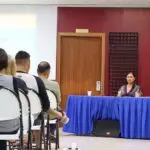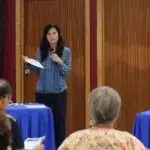Jump Start Your Art
Table of Contents
Share This
Marketing, Resources, and Guides
The Guam Council on the Arts and Humanities Agency (CAHA) hosted Jump Start Your Art: Marketing, Resources and Guides – two workshops for artists, cultural producers and entrepreneurs in 2016. These educational and capacity building workshops enabled artists to connect with representatives from various fields in a creative business.
The workshops were held on 24 September 2016. The morning session focused on marketing, communications, having an online presence, and a review of copyrighting law. The afternoon session focused on community resources and opportunists with stories of success and experience from fellow artists and entrepreneurs. Workshops were held at the CAHA Gallery, then located in the Terlaje Professional Building in Hagåtña.
Session I: Marketing & Copyright
Marketing
Rita P. Nauta, Guampedia.com
There are many ways to connect with an audience, long time marketer Rita Nauta said, but there is a big difference between just getting exposure and getting an audience’s attention. Artists need to learn to differentiate between just getting exposure and building relationships with potential customers. Artists are their own brand and must keep the brand’s promise. However, she reminded the participants, artists may not be their own target audience.
At the time, Nauta had worked with Guampedia for about 10 years, documenting history and making it accessible through the web and community presentations. She learned that without artists such as writers and photographers, history wouldn’t be documented.
“All of you are so important to Guam and our lives,” Nauta said. “We live in the information age. Art is everywhere. It used to be that you just had to get your art and your name out there. But now there is so much competition. Now we need to get people’s attention – the right people’s attention.”
She advised workshop participants to always reflect on their passion and make sure their “brand” matches who they are. That way you can capture the attention of the market that fits with you.
Rita Nauta e-publication
Media & Promotions
Rick Nauta, Moy Communications
Radio host and media star Rick Nauta said 31 years in the business had taught him a few things. He believes that artists are a community’s treasures. They are often independent, proud and can be mercurial and misunderstood with a part of themselves just wanting to be understood. Art is not just about expressing yourself but also communicating with others.
He advised the artists and cultural producers at the workshop to pay attention to what’s going on around the island and figure out ways to join in and be seen. Bring your art into other’s events, he advised, so that it will be photographed and shared and people will get to know you and your work.
As a radio man, Nauta said his art is all in the imagination but that’s where emotion comes from. As a programmer he wants to play songs that make people have fun. Artists need to read the audience and then give the people what they want.
Marketing Online
Ana M. Babauta, Capilli Miles
Artists can create the most beautiful things but people need to be able to find them in the online environment, Ana M. Babauta, digital strategist, told workshop attendees. There is a strategy to bring customers to your work on line, called Search Engine Optimization (SEO), Babauta explained.
The goal of SEO is that when someone Googles your name or your company name the first thing that shows up on the findings list is your website. There are three components to this strategy that help people find you online:
- Paid – This is media that you pay for such as print, television, radio, movie theaters and banners.
- Owned – These are things you’ve created such as a brochure, items in retail stores, your website, your community, Facebook, possibly a fan page, a mobile app, Twitter, Instagram and other online sites.
- Earned – These are things people say about you and your work online such as when they post or repost an article about your work and bring your name up in an online forum.
Ana Babauta e-publication
Copyright & Uncopyright
Attorney Therese Terlaje, Legislature Legal Counsel
When an artist creates something it belongs to them and is their intellectual property. There are avenues set up by the law to protect that ownership and further their claim to their own work. The gist of copyright is to protect your property, according to Therese Terlaje, attorney and senator. She said the tools to copyright your work are available on line and not that difficult to use. She recommended the Cornell Law website on copyright and the Guam Compiler of Laws websites. Cornell’s site is easy to use and the Guam site is great for researching Guam laws.
Artist should understand that there are various laws that deal with protecting intellectual property such as copyright, patent, trade secrets and trade mark, Terlaje said.
More reference materials can be found in CAHA workshop Protecting Intellectual Property.
Session II: Resources & Guides
Community Resources
Department of Chamorro Affairs (DCA)
Johnny Sablan, President
When Johnny Sablan, then the Department of Chamorro Affairs president, first began recording his music in 1968 he said he had so much to learn. He was told, for example, that in order for his songs to play on the air they had to be less than four minutes long. He had grown up the son of business people who told him that it’s not about the money, it must be about providing items or content that people will like.
“In other words, don’t think about making money but rather about making something worthwhile,” he said. Packaging is important too, nothing fancy, but just nicely done. His recordings, all made between 1968 and 1971, are still being sold today.
He said that producing Chamorro music turned him into an activist, fighting for the Chamorro culture and pursuing his Chamorro identity. He wanted to contribute what was essentially Chamorro into the international music scene. As there were no recording studios on Guam at the time he recorded his albums in California.
Guam Unique Merchandise & Art (GUMA)
Clifford Guzman, Executive Director
Cliff and Monica Guzman did research a few years earlier to see what Guam gifts visitors to Guam could buy. They figured out that 95 percent of the items labeled “Guam” were not made on Guam. They asked retailers why they didn’t carry items made by Guam artists and found out that they wanted to do so but needed items to meet certain criteria – they must have a regular supply, be of consistently good quality and be packaged nicely.
The Guzmans decided to come up with a plan to change that picture. DFS was interested and had worked with artists in Cambodia on a similar project. They wanted to help. The Guzmans created a non-profit organization that included themselves, an attorney who knew copyright issues, a CPA and a banker. Guam Unique Merchandise and Art was born.
GUMA e-publication
Guam Council on the Arts and Humanities Agency (CAHA)
Sherrie Barcinas, Administrative Officer
The Guam Council on the Arts and Humanities Agency (CAHA) has numerous programs for artists. Sherrie Barcinas, CAHA administrative officer at the time, said the first of these, the Artists Registry, helps g et the word out to artists about workshops and events and also is an avenue for CAHA to let Guam artists know if there is an art opportunity.
Besides the Artists Registry CAHA administers grants programs, provides a gallery for art shows and recognizes artists at the masters level.
Guam Economic Development Authority (GEDA)
Julius Santos, Industry Development Specialist
The Guam Economic Development Authority does its part to encourage the arts and culture on Guam. Julius Santos, GEDA’s industry development specialist at the time, said that Guam’s gross domestic product is up to $5.7 billion annually, in part due to GEDA’s programs to encourage investment on Guam. A strong economy is good for the arts.
Santos, an artist himself in the radio, television and film industries, said that GEDA can act as a bank for start ups providing loans to small businesses through the Guam Development Fund Act. It also directs money from its Qualifying Certificate program (an incentive tool to bring investment into Guam) into the Percent for the Arts Program. GEDA also administers the Guam Product Seal program.
GEDA e-publication
Guides
Sirena’s Soul
Cora Yanger Bejado, Artist and Owner
Cora Yanger Bejado, owner of Sirena’s Soul, said she was into arts and crafts since she was a child. As number 11 of 12 brothers and sisters, she explained, she never knew how to keep still and she always liked to work. “I love the cultures I come from, both Chamorro and Filipino,” Bejado said. “And I have a daughter who thinks she has a mermaid inside her.” The two of them work together to create unique handmade jewelry.
Isla Rae
Rebecca Rae Davis, Artist and Owner
Being from Guam was always a good thing for artist and jewelry maker Rebecca Rae Davis. The many opportunities to get involved and be a part of the community available on Guam added to her wisdom.
“We have such a participating and sharing community,” she said. “I chose to enrich my soul and grow from there. It’s always made me feel super rich (being from Guam).”
Davis studied various forms of art, eventually coming back home and starting her own art studio.
She wanted to create her own sense of place and did so at islarae.net where visitors can see her work and that of her partners.
Rebecca Davis e-publication
Guam International Film Festival (GIFF)
Don & Kel Muna, Filmmakers
Don and Kel Muna, movie producers and founders of Guam International Film Festival, described themselves as rascals from the village, learning what they know by watching their mom.
“Be on time, always deliver what you promised, bring your “A” game, and wear slacks to church,” Don Muna said.
The Muna Brothers said they were financially broke and really didn’t relish the idea of getting 9 to 5 jobs. “Dude, let’s make a movie,” Don said. They used a credit card to get the equipment they needed and vowed to stay true to their heart, make the movie memorable and stayed the course until it was done. “The key thing was you can’t be lazy,” Don said. “You gotta do what you gotta do.”
Summary Workshop Report
Written and presented by Guampedia.com
Go to Guam CAHA Workshops here.

